If you’re planning a trip to Trieste and its surroundings, a visit to Miramare Castle should definitely be on your list of must-see things.
Along with Piazza Unità d’Italia, it is the most iconic and photographed place in the capital of Friuli Venezia Giulia.
Exploring the lavishly decorated rooms, admiring the breathtaking views of the gulf through the windowpanes, or strolling along the park’s pathways, everything exudes the aura of ancient nobility.
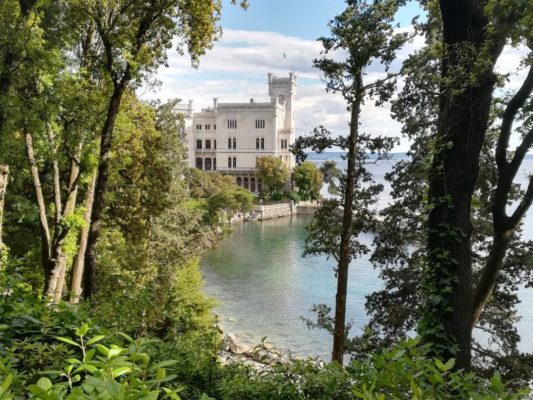
Glimpse of the Castle seen from the park
For the locals, on the other hand, Miramare Castle is the perfect destination for a Sunday outing. They reach it by taking a leisurely stroll along the city’s most famous waterfront promenade, Barcola.
They pause on the wooden park benches to chat or read a book, enjoy a coffee or a refreshing drink at the bar, or simply admire the surrounding landscape.
As for students in our region, a visit to the castle is almost a mandatory part of their school trip itinerary, often combined with other attractions in the city.
Last update 2nd April 2024.
Table of Contents
- Location
- How to get there
- Parking information
- Historical background
- Visit to Miramare Castle
- Maximilian and Carlotta
Location
Miramare Castle stands on the promontory of Grignano, in a captivating location that stretches out into the sea.
Grignano is a small town located on the northern outskirts of Trieste, approximately 9 km away from Piazza Unità d’Italia, one of the most beautiful squares in our country.
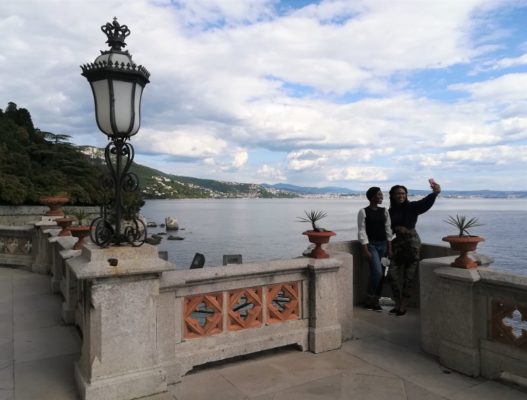
Panorama of the Gulf of Trieste
How to get there
For those coming from the A4 highway (from Venice and Palmanova):
we recommend exiting the motorway at Sistiana and then taking the scenic coastal road SS14.
Along this panoramic route, you can stop at the lookout points and admire captivating views of the Gulf of Trieste.
From the center of Trieste:
Miramare can also be reached by public transport. From the square in front of the central train station, you can take bus lines number 6 and 36, which will take you to your destination.
Alternatively, an idea is to arrive at the castle by sea. During the summer period, roughly from June to early September, there is a maritime transport service that connects Trieste with Sistiana.
The dock is located on the waterfront of Nazario Sauro, right at the corner with Molo Bersaglieri. The motorboat makes two intermediate stops, one at Barcola and one at Grignano, just behind the castle.
There are four daily trips, and you can check the schedules and fares (including those of the buses) on the Trieste Trasporti website.
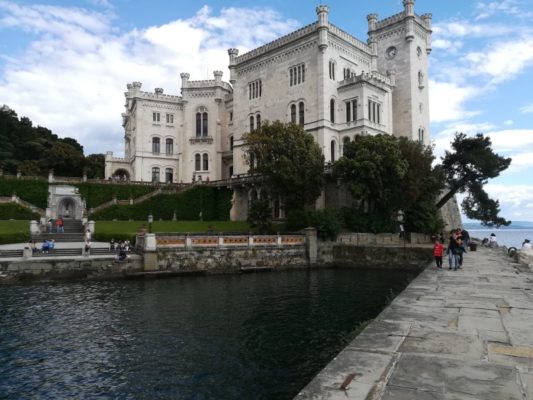
The Castle seen from the little harbour
Parking information
Especially during the summer and on national holidays, the castle area is a very popular attraction. The waterfront quays of Regina Elena and Viale Miramare are often crowded with beachgoers.
However, if you manage to find a parking spot, parking is free.
At the end of Viale Miramare, there is a guarded paid parking lot, although the rates are not exactly cheap.
Historical background
Before visiting Miramare Castle, it’s interesting to understand the historical context in which the city existed during that period.
Trieste, following a long dispute with the Republic of Venice, requested and obtained the protection of the Duke of Austria in 1382.
As a result, it remained under the influence of the Habsburgs until the end of World War I, with the exception of three periods (the last of which lasted a few years) when it was occupied by Napoleon’s troops.
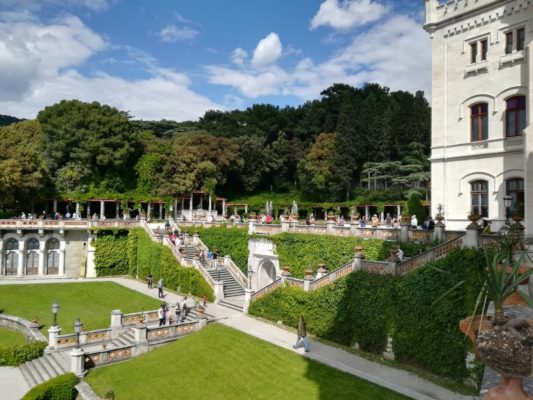
Castle garden
The imprint of its imperial past is still recognizable in the architecture of the splendid palaces in the historic center, the squares, the gardens, and the Miramare complex.
The manor and the surrounding park were built by the will of Archduke Maximilian of Habsburg.
The foundation stone of the building was laid on March 1, 1856, and four years later, just a few days before Christmas, the Archduke and his consort, Carlotta of Belgium, made it their residence.
Visit to Miramare Castle
Access to the actual castle area is through an arched gate called the “Porta della Bora“.
It was built specifically to mitigate the strong gusts of wind that characterize Trieste and the Karst region.
Just past the entrance, you will find the tourist information office managed by Promoturismo FVG.
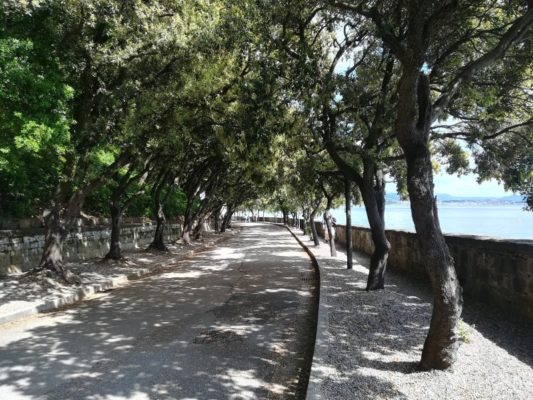
The Avenue of the Oaks
You will then embark on Viale dei Lecci (the Avenue of the Oaks), characterized by the presence of oak trees lining the pedestrian path and a rich undergrowth of laurel and viburnum on the right side of the trail.
During this short journey, I recommend leaning over the low wall and casting your gaze towards the sea.
Guided Tour
If you want to have a complete experience of Trieste, I recommend participating in a guided tour of the historic center and Miramare Castle.
The excursion through one of the most beautiful cities in Italy lasts about 4 hours, and the guide speaks English.
Visit Miramare Castle and take a walk through the beautiful botanical gardens with breathtaking panoramic views.
To end the day on a high note, you can visit an “osmiza” to taste typical products of the Karst region.
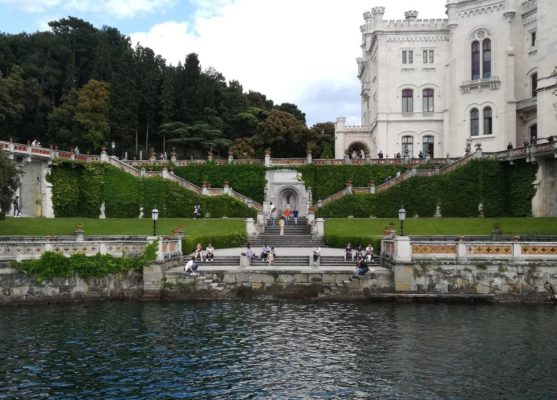
The Castle little harbour
Miramare Castle, ticket prices
The entrance fee to Miramare Castle is €12.00 (as of 2024).
For citizens of the European Union between the ages of 18 and 25, the fee is €2.00.
Every first Sunday of the month, admission to the castle is free for all thanks to the initiative of the Italian Ministry of Culture “Sunday at the Museum”.
There is free admission also for various categories of visitors, which can be consulted on the website of the Historical Museum and the Park of Miramare Castle.
It is possible to book the entrance ticket online on the website, with the additional cost of the reservation fee.
The park, on the other hand, is open year-round (except for Christmas and New Year’s Day) and admission is free.
Visit duration
To fully visit Miramare Castle, including a walk in the park to reach the Castelletto and the marina of Grignano, descending into the garden and the small harbor, and taking customary photo stops, it typically takes around two and a half hours.
The Castle
The design of the castle was created by the Austrian engineer Carl Junker, who drew inspiration from the eclectic architecture of the time, combining elements of the Gothic, Medieval, and Renaissance periods.
The interiors, on the other hand, were crafted by artisans Franz and Julius Hofmann.
The visit to the Historical Museum takes place on two floors and begins in the Atrio d’Onore (Honour Hall).
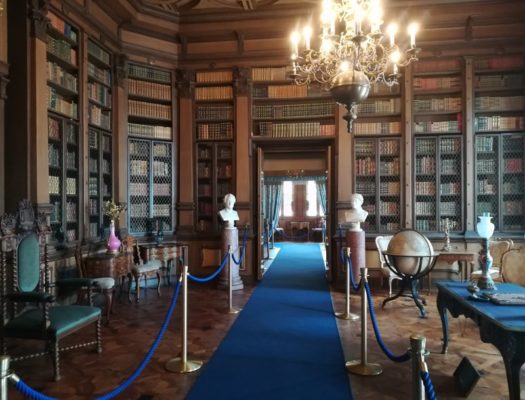
The Castle library
The lower floor was dedicated to the private apartments of Massimiliano and Carlotta, while the upper floor, adorned with splendid red tapestries, housed the grand reception halls.
Overlooking the atrium are both the main entrance to the castle and the entrance from the small harbor, known as the Sala della Rosa dei Venti (Room of the Compass Rose).
The rooms that impressed us the most during the visit were:
Ground floor:
- La Cabina (The Cabin): This is where the Archduke’s private apartment begins, and the room is a true reproduction of a ship’s cabin. The ceiling is lowered, and the walls are covered in wood;
- La Biblioteca (The Library): In the room dedicated to reading and daily work, the volumes of Massimiliano and Carlotta are preserved, still arranged according to the original layout.
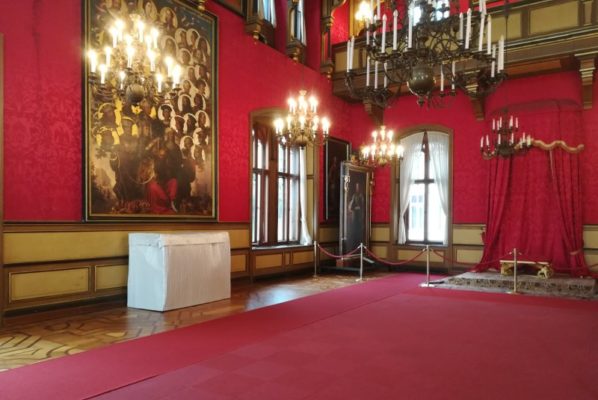
The Throne Room
First floor:
- La Sala del Trono (The Throne Room): This room has recently been restored to its original model. Large paintings depicting the most important emperors of the Habsburg dynasty adorn the top of the walls;
- La Sala delle Udienze (The Audience Room): The red fabric on the walls was chosen by the Archduke and is present throughout the first floor. It was woven after his appointment as the Emperor of Mexico.
After the death of Massimiliano and Carlotta’s departure to Belgium, the castle occasionally hosted representatives of the Habsburg family.
Among them was the famous Empress Elisabeth of Austria, also known as Empress Sissi, who stayed at Miramare several times.
Between 1931 and 1937, the castle became the residence of Duke Amedeo of Savoy-Aosta before his departure for Africa.
The Park
The park is located on a rocky promontory consisting of white limestone bastions that contrast with the darker rocks along the Gulf coast.
Covering an area of 22 hectares, the park features a network of gravel and asphalt paths where you can find benches to rest and enjoy moments of relaxation surrounded by nature.
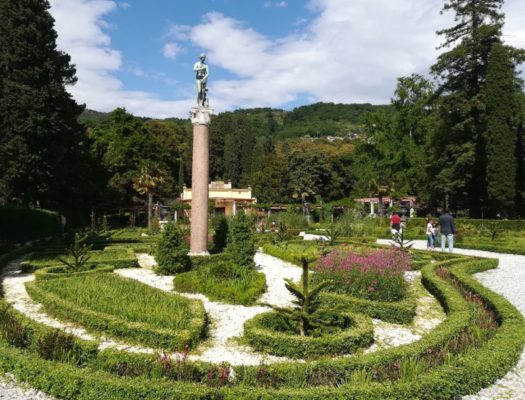
The park of the Miramare Castle
The areas closest to the castle have a garden-like structure, with well-maintained geometric flower beds.
The more peripheral areas, on the other hand, are more wooded, with a variety of medium and tall trees, ponds, and gazebos.
The park is home to a wide variety of plants and trees, many of which are of non-European origin.
The Castelletto
The Castelletto is located at the northern end of the park and was designed by Carl Junker, in harmony with the architectural style of the castle. It was inhabited by Massimiliano and Carlotta before they moved into the main building.
When we visited, the structure was undergoing restoration work. On the upper floor, there are some rooms decorated in eclectic style and a Moorish hall, some of whose furniture comes from Villa Lazarovich, Massimiliano’s first residence in Trieste.
On the square in front of the complex, beyond the fountain and the garden, you can see the original structures of the greenhouses.
They were used for the cultivation of numerous plant species and botanical experimentation.
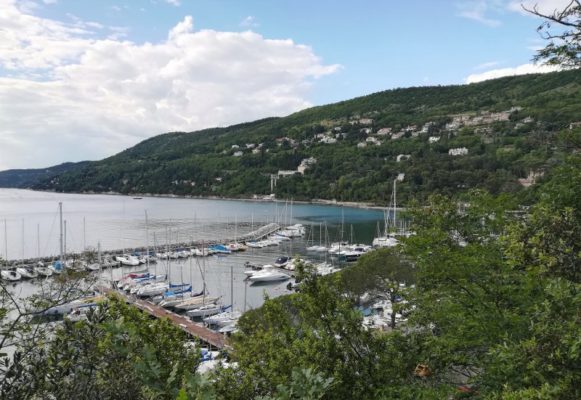
The little Port of Grignano
On the back side, surrounded by vegetation of strawberry trees, there is a beautiful viewpoint overlooking the port of Grignano.
Here’s an interesting fact: The Barcolana, the historic sailing regatta that attracts thousands of boats, is organized every year by the Società Velica di Barcola e Grignano.
It takes place at the beginning of October.
The Stables
The stables of the Castle are located in the area preceding the Porta della Bora, thus outside the main complex. This building, designed by Carl Junker, was constructed between 1856 and 1860.
It consists of a central body and two symmetrical side wings. In the past, it housed horses and carriages, but today it hosts temporary exhibitions.
Additionally, one of the wings is dedicated to the BioMa, the Marine Biodiversity Center.
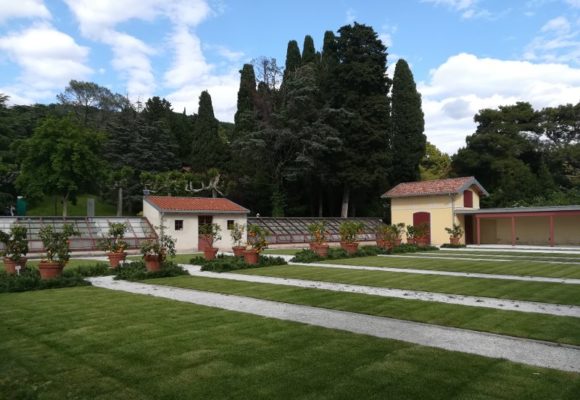
The greenhouses
Maximilian and Carlotta, a short history
Ferdinand Maximilian of Austria was born on July 6, 1832, in the famous imperial palace of Schönbrunn Castle in Vienna. He was the second son of Archduke Franz Karl and Princess Sophie of Bavaria.
Carlotta, on the other hand, was born on June 7, 1840, in Laeken near Brussels. Her parents were Leopold I of Belgium and Louise Marie of Orléans.
Maximilian and Carlotta first met at a court ball in Laeken in 1856. After several cruises in the Mediterranean, in February 1857, Maximilian received the appointment of Governor of the Lombardo-Venetian Kingdom from his brother, Emperor Franz Joseph.
On July 27 of the same year, the two got married. Two years later, the Archduke resigned from his position as Governor, and the couple moved from Milan to their beloved Trieste.
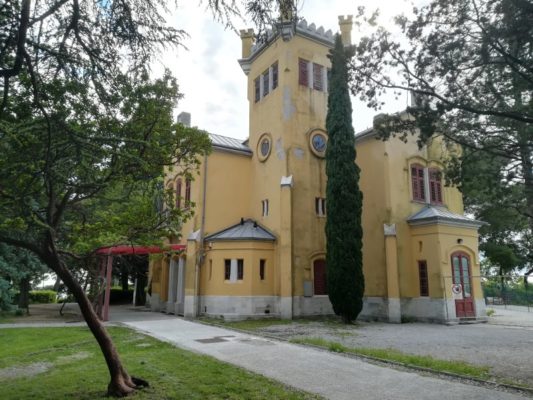
The Castelletto
On October 3, 1863, a delegation of Mexican nobles arrived at the castle and, on behalf of Napoleon III, offered Maximilian the crown of Mexico. The Archduke accepted and became Maximilian I of Mexico.
In 1864, in front of his brother, Maximilian renounced his hereditary rights to the Austrian royal house and, together with his wife, set off for Mexico. Upon their arrival, they found a country engulfed in a brutal civil war.
Due to the deteriorating political situation, Carlotta returned to Europe to seek help from Napoleon III and Pope Pius IX. Both denied her the requested support. From that moment, Carlotta began to manifest mental health problems.
Maximilian was captured in 1867 by the republicans led by Benito Juárez in Santiago de Querétaro and was executed on June 19 of the same year.
Unaware of her husband’s fate, Carlotta left Miramare Castle and moved to Belgium, where she died in 1927.
On January 18, 1868, Maximilian’s remains were brought back to Trieste and later interred in Vienna.



0 Comments